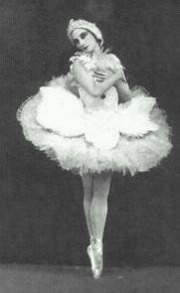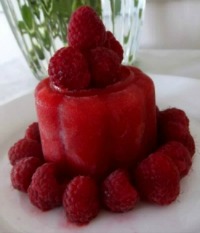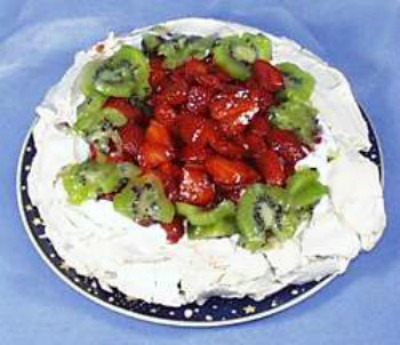 Pavlova (pav-LOH-vuh) – The elegant Pavlova Cake (or pie) consists of a base made of a meringue crust topped with whipped cream and fresh fruits such as kiwis, strawberries, etc. In Australia, it is considered a fresh fruit pie with a meringue crust.
Pavlova (pav-LOH-vuh) – The elegant Pavlova Cake (or pie) consists of a base made of a meringue crust topped with whipped cream and fresh fruits such as kiwis, strawberries, etc. In Australia, it is considered a fresh fruit pie with a meringue crust.
No one knows who first created the famous dessert Pavlova. But the name and the recipes first began appearing soon after Russian prima ballerina and choreographer, Anna Matveyevna Pavlova (1881-1931), began touring across America, Europe, and the UK in 1910. In America, she danced at the Metropolitan Opera House in New York. Anna Pavlova was one of the most celebrated and influential ballet dancers of her time.
In 1911, Anna Matveyevna Pavlova founded her own ballet company that was the first to tour ballet around the world. For two decades, she toured around the world. She also toured both Australia and New Zealand in 1926 and Australia again in 1929. Anna Pavlova was considered the greatest ballerina of her time and her visit to New Zealand has been described as “the chief event of 1926.” It was said “She does not dance; she soars as though on wings.” From this you get the sense that this is a light, airy dessert.
Attention: The following historical information was shared with me by Annabelle Utrecht, on December 3, 2015. The below history information is by Dr. Andrew Paul Wood, a New Zealand art historian, cultural critic and journalist and by Annabelle Utrecht, an Australian production company owner, researcher, write, cultural enthusiast, and cake enthusiast. Check out their website: Pavlova – A cake and its secret history:

Well, I just wanted to let you know that while I now have a contender for ‘pavlova ice-cream’ – I am more excited to reveal that I’ve discovered a pavlova glace recipe which significantly pre-dates any of the first pavlova recipes which emerged in the southern hemisphere by some 15 to 18 years. The recipe I discovered is called ‘Strawberries Pavlova.’ Essentially, it is a cheeky. red berry glace, or ice. Although Strawberries Pavlova emerges in Auckland, NZ in 1911 and three weeks later in Oamaru, NZ – it is not a New Zealand dish. This dessert is a northern hemisphere presentation. I made it a month ago and have attached a photo for you to see. Its arrival in the culinary dialogue effectively alters foodways history and begs the question, is the Antipodean Pavlova origin story even true?
Early in 2014, I teamed up with Dr Andrew Paul Wood, a Kiwi cultural critic, art historian, and author. Since then we have made many discoveries which will change the whole pavlova story. In fact our research suggests the new stake-holders of the pavlova dessert’s origins, are the United States and Great Britain! The cake we know of today as ‘pavlova’, is actually an American innovation. I don’t want to bore you, but trust me, the national dish of both Australia and New Zealand – was made in the good old USA first!
Anyway, just wanted to touch base, as I promised I would, and let you know that ‘Strawberries Pavlova’ of 1911 is now the world’s oldest pavlova-named recipe. Dr Wood and I have so much more to reveal and we are hoping to publish all our discoveries next year. Since we began researching, we have discovered that there were British, European, and American Pavlova-named desserts and savory dishes well before any Antipodean dessert namings. We also discovered that the famous Antipodean ‘Pavlova Cake’, is in actual fact, a re-branding or appropriation of Germanic tortes which were modernized in the American Midwest by the 1860s.
Claims that the Pavlova Cake was invented in the southern hemisphere are entirely false; the United States had Pavlova-like tortes first!
Pavlova Cake photo courtesy of the Fabulous Foods website
Meringue History:
1604 – The earliest recipe for a meringue made of sweetened and beaten egg whites appeared in a small leather-bound recipe book by Lady Elinor Fettiplace (1570-1647) that was called White Bisket Bread. This recipe book provides an intimate glimpse into the fabric of everyday Elizabethan life, as well as a link in the history of English cooking:
United States Pavlova History:
The below United States history information is by Dr. Andrew Paul Wood and by Annabelle Utrecht.
1911 – The discovery of the 1911 ‘Strawberries Pavlova’ recipe definitely changes culinary history (see above). Back in 1911, most Australians and New Zealanders would barely have known who Anna Pavlova was – and there was certainly no occasion or reason to create a special dish in her honor in the southern hemisphere at that point.
Anna Pavlova was however, a dancing sensation across America, Europe, and the UK by 1911. It is believed ‘Strawberries Pavlova’ is a northern hemisphere homage to her. Not only is it now the world’s oldest known Pavlova-named dish (predating the jelly Pavlova by 15 years) – but its existence suggests that current culinary theory is incorrect.
Since we began researching, we have discovered that there were British, European, and American Pavlova-named desserts and savory dishes well before any Antipodean dessert namings. We also discovered that the famous Antipodean ‘Pavlova Cake’, is in actual fact, a re-branding or appropriation of Germanic tortes which were modernized in the American Midwest by the 1860s. Claims that the Pavlova was invented in the southern hemisphere (Australia and New Zealand) are entirely false; the United States had Pavlova-like tortes first!
New Zealand Pavlova History:
For many years, there has been a history of conflict between both Australia and New Zealand. While it has been suggested this dessert was created in New Zealand, it has also become recognized as a popular Australian dish. Both countries claim to have invented this dessert and claim it as their national dish.
1926 – Keith Money, a Pavlova biographer, wrote in his 1982 book, Anna Pavlova: Her Life and Art, that a chef at a hotel in Wellington, New Zealand created a dessert dish for Pavlova when she visited there in 1926 on her world tour. The hotel chef was inspired by her tutu that was draped in green silk cabbage roses. The basic shape of the tutu was provided by a meringue case, while the froth of the skirt’s net was suggested by whipped cream. To achieve the effect of the green roses the enterprising chef used slices of kiwifruit, then known as Chinese gooseberries.
1926 – In New Zealand, a cookbook published in 1926 by E. Futter titled Home Cookery for New Zealand contained a recipe for “Meringue with Fruit Filling.” Although the name Pavlova is not used, the recipe is similar. Because of this recipe, New Zealanders claim to have originated the recipe. They say that the Australians used this recipe and called it Pavlova.
1927 – According to Volume III (published in 1982) of the supplement to the Oxford English Dictionary to the first published reference to a “Pavlova” was contained in “Davis Dainty Dishes” (sixth edition) published in 1927 by Davis Gelatine New Zealand Ltd. This recipe for pavlova included gelatin.
Australia Pavlova History:
1935 – According to chef Herbert (Bert) Sachse of the Hotel Esplanade in Perth, Western Australia, the dessert was originally created as a tea dessert for the Hotel’s afternoon teas. According to the Paxton family legend, the Pavlova was named at a meeting at which Sachse presented the now familiar cake. The family say that either the licensee, the manager, or chef Sachse remarked, “It is as light as Pavlova.” It was then named Pavlova after the great Russian ballerina, Anna Pavlova, who had been a guest of the hotel during her 1929 tour of Australia. In 1973, Herbert Sachse stated in a magazine interview that he sought to improve the Meringue Cake recipe that he found in the Women’s Mirror Magazine on April 2, 1935. The recipe was contributed by a New Zealand resident.
“In 1973 at the Victoria Hotel, we had an evening chef who was superb. He was an 80 year old man of Greek extraction. His name was Nick. He told us that he had worked at the Esplanade Hotel, in Perth, as a very young apprentice chef. He worked in the kitchen of the Esplanade Hotel with the head chef at the time the Pavlova was invented there. My husband John and I were general managers of the Victoria Hotel and Nick was an outstanding chef. He often made Pavlovas especially for us and our kids as special treats. – Marlene Harding Perth Western Australia (10/5/14)


4 Responses to “Pavlova Cake History”
Pixi Robertson
I was a Cecchetti Method ballet student in Perth in the 1960s. A friend of my teacher, Mavis Rosewarne Holdcroft, was a Mrs Yulverton. Unfortunately I do not know her first name, but she was a member of a prominent Perth family and a balletomane of the old style. I remember Mrs Yulverton reminiscing about having supper with Anna Pavlova at the Palace Hotel in Perth where they were served with the ubiquitous meringue dish created for the dancer.
Annabelle Utrecht
That’s a fascinating piece of information Pixi. Thank you for sharing it. Mrs Yulverton’s account would be the second such testimonial I’ve heard in the past month. What a pity she didn’t put it in writing. Would you know if Mavis Rosewarne Holdcroft is still alive? A witness statement would be quite useful. I am co-authoring a book with Dr Andrew Paul Wood on the subject of the pavlova’s origins and all these little anecdotes combine to present an interesting case. Many thanks again.
Johnatathan
Haha!!! Americans!!!”A new listing in the Oxford English Dictionary says the meringue-based dessert was invented in New Zealand.
Australia has long tried to claim it created the Kiwi treat, named after the Russian ballerina Anna Pavlova who visited the Antipodes in the 1920s.
That claim has now been debunked after the Oxford yesterday relaunched its online edition, saying the first recorded pavlova recipe appeared in New Zealand in 1927.
http://www.stuff.co.nz/life-style/food-wine/4418676/New-Zealand-wins-pavlova-war
Lorand Bartels
The whole point of a pavlova is that it is not just a meringue crust. It’s the soft part inside that counts. All those fake pavlovas (from 1604 onwards) get this wrong. It’s like carbonara with cream instead of eggs, or tiramisu without the soaked biscuits. Or decaffeinated coffee. Or Coke Zero. You get the point.